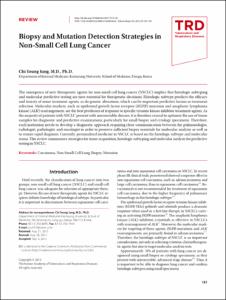KUMEL Repository
1. Journal Papers (연구논문)
1. School of Medicine (의과대학)
Dept. of Internal Medicine (내과학)
Biopsy and Mutation Detection Strategies in Non-Small Cell Lung Cancer
- Keimyung Author(s)
- Jung, Chi Young
- Department
- Dept. of Internal Medicine (내과학)
- Journal Title
- 결핵 및 호흡기 질환
- Issued Date
- 2013
- Volume
- 75
- Issue
- 5
- Abstract
- The emergence of new therapeutic agents for non-small cell lung cancer (NSCLC) implies that histologic subtyping and molecular predictive testing are now essential for therapeutic decisions. Histologic subtype predicts the efficacy and toxicity of some treatment agents, as do genetic alterations, which can be important predictive factors in treatment selection. Molecular markers, such as epidermal growth factor receptor (EGFR) mutation and anaplastic lymphoma kinase (ALK) rearrangement, are the best predictors of response to specific tyrosine kinase inhibitor treatment agents. As the majority of patients with NSCLC present with unresectable disease, it is therefore crucial to optimize the use of tissue samples for diagnostic and predictive examinations, particularly for small biopsy and cytology specimens. Therefore, each institution needs to develop a diagnostic approach requiring close communication between the pulmonologist, radiologist, pathologist, and oncologist in order to preserve sufficient biopsy materials for molecular analysis as well as to ensure rapid diagnosis. Currently, personalized medicine in NSCLC is based on the histologic subtype and molecular status. This review summarizes strategies for tissue acquisition, histologic subtyping and molecular analysis for predictive testing in NSCLC.
Keywords: Carcinoma, Non-Small-Cell Lung; Biopsy; Mutation
- Keimyung Author(s)(Kor)
- 정치영
- Publisher
- School of Medicine
- Citation
- Chi Young Jung. (2013). Biopsy and Mutation Detection Strategies in Non-Small Cell Lung Cancer. 결핵 및 호흡기 질환, 75(5), 181–187. doi: 10.4046/trd.2013.75.5.181
- Type
- Article
- ISSN
- 1738-3536
- Appears in Collections:
- 1. School of Medicine (의과대학) > Dept. of Internal Medicine (내과학)
- 파일 목록
-
-
Download
 oak-bbb-00151.pdf
기타 데이터 / 319.36 kB / Adobe PDF
oak-bbb-00151.pdf
기타 데이터 / 319.36 kB / Adobe PDF
-
Items in Repository are protected by copyright, with all rights reserved, unless otherwise indicated.